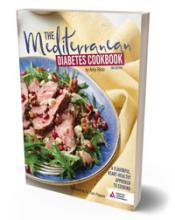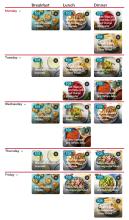Meal planning is a powerful tool for diabetes management. Planning out your meals for the week helps you build a grocery list so you buy just what you need. And once you have everything on hand, it's easier to prepare meals throughout the week and stick to your plan. Read on for tips from cookbook author Amy Riolo on Mediterranean-style meal planning, and a one-week Mediterranean meal plan to get you started!
Amy Riolo is author of The Mediterranean Diabetes Cookbook.You can order a copy of the new edition directly from the American Diabetes Association by clicking here.
Getting Started with Meal Planning
When planning a Mediterranean menu, it’s important to consider the season, region, occasion, and personal traditions. According to the Mediterranean-style eating pattern, the largest portion of our daily diet should come from plant-based foods, with vegetables topping the list. Vegetables are at their peak flavor (and often cheaper) when they are in season and locally grown. As you start planning your meals for the week, find out what vegetables are in season or on sale at your local grocery store, and choose your recipes based on those vegetables.
Nutrition Considerations
Throughout the Mediterranean region, a balanced meal is considered to contain carbohydrates, protein, and fats. The more healthful choices you make in those categories, the better your meal will be: whole grains and vegetables are ideal sources of carbohydrates; lean proteins such as fish and chicken are great protein choices; and nuts, olives, avocado, yogurt, and lean cheeses provide healthy fats.
Recipes from the American Diabetes Association contain nutrition information, serving size, and exchanges/choices, so you know exactly what you’re putting on your table. It can be difficult to figure out exactly how much carb, protein, or fat you’ll get out of a homemade dish, which is where this information comes in handy.
There are several tools that can help people with diabetes plan meals such as exchanges/choices, the plate method, and carb counting. The best way to learn more about these tools is to meet with your registered dietitian or diabetes educator. And remember, where, when, and how you eat are also important components of the Mediterranean lifestyle.
Tips for Medtierranean-Style Meal Planning
Breakfast:
- Some people prefer to start the day with a quick, light breakfast, others prefer a hearty breakfast to keep them full until lunchtime. Consider your morning routine, blood glucose levels, and food preferences, and find a breakfast routine that works for you.
- If your mornings are hurried, keep plenty of low-fat yogurt, whole-grain cereal, part-skim cheese, nut mixes, and fresh fruit on hand for breakfast-on-the-go.
- Find recipes that you can prepare ahead of time for a homemade grab-and-go breakfast.
Lunch:
- One of the easiest ways to make lunch is to bring leftovers from the previous night’s meal. If you don’t like eating the same thing two days in a row, freeze individually portioned meals and defrost them for lunch as needed.
- Make large batches of salads and pack them in individual serving-size containers with dressing on the side to bring to work.
- For days when you can’t bring lunch, keep your own “menu” of tasty and healthy lunch options from nearby stores or cafes.
Dinner:
- Plan weekday dinners ahead of time (get the whole family involved!) and make sure you have everything on hand each night to stick to the plan.
- When you have some extra time to spend in the kitchen, prepare extra meals for another day, or prep ingredients to cut down the cooking time on busy weeknights.
One-Week Mediterranean Meal Plan
Here is a sample Mediterranean meal plan using recipes from The Mediterranean Diabetes Cookbook. The recipes contain a variety of cooked and raw vegetables for interesting texture and variety. Lean protein sources include salmon, turkey breast, lamb, and lentils. I’ve provided an example of how these recipes can be arranged in a weekly meal plan, using leftovers throughout the week to cut back on cooking and prep time. You can use these recipes to build your own meal plan using the Diabetes Food Hub meal planner: Save the recipes, then drag and drop them into the meal planner. Once you have everything in place, you can even generate a grocery list to make shopping easier.
For more help using the meal planner, check out this tutorial.
Breakfast:
Lunch/Dinner:
Snacks/Dessert:
*These recipes are great to make ahead of time. Prepare them over the weekend or whenever you have some extra time for cooking, and portion them in individual serving containers for grab-and-go breakfast or lunch.










